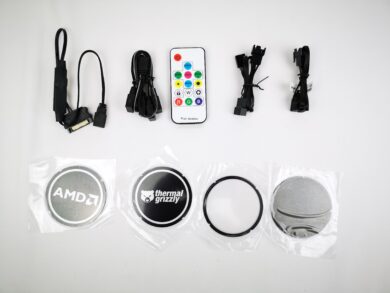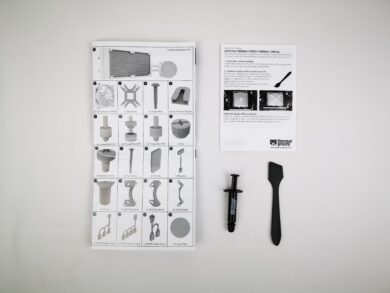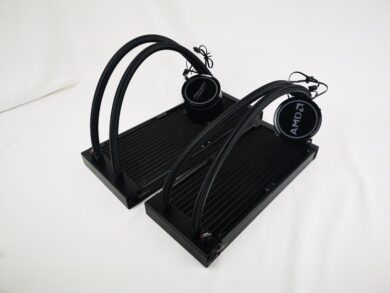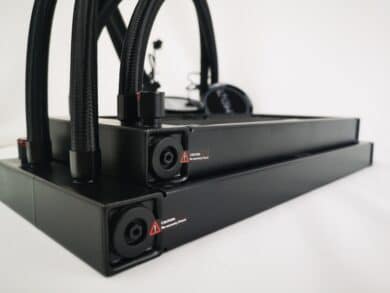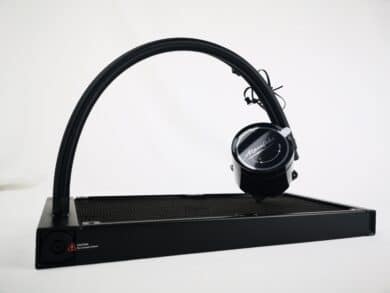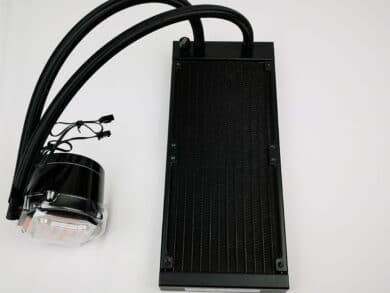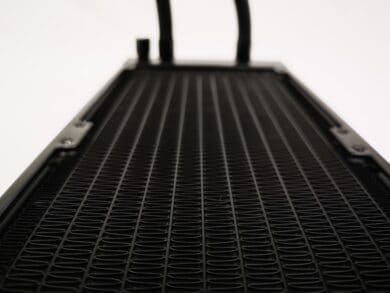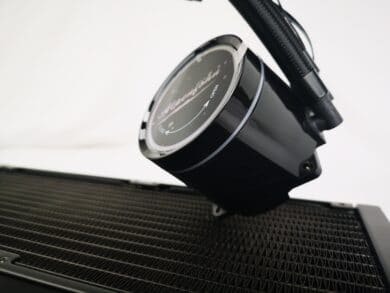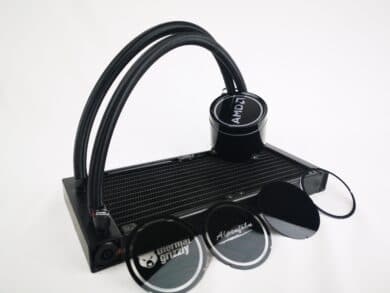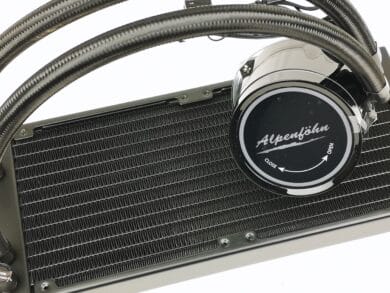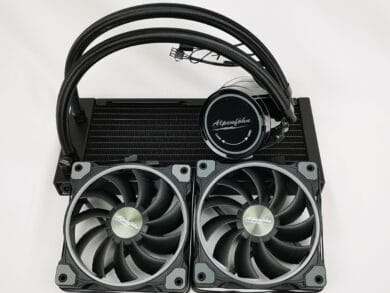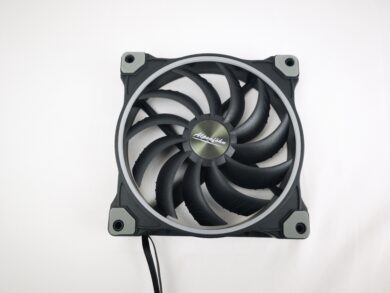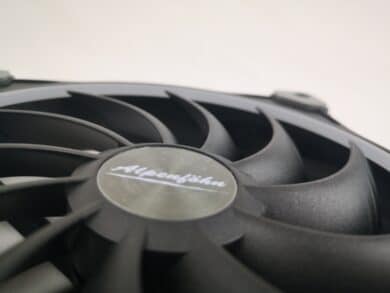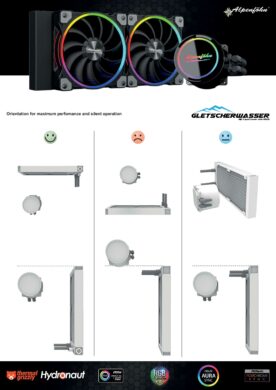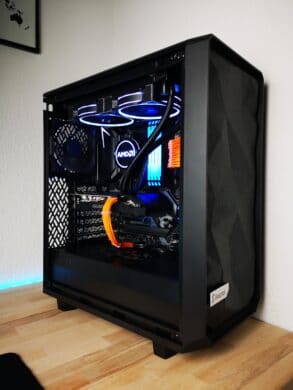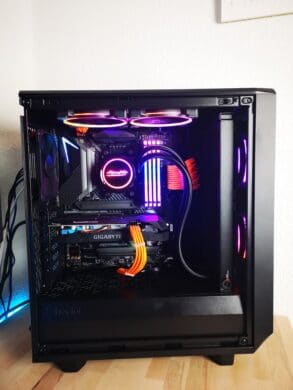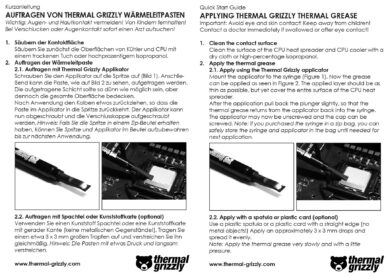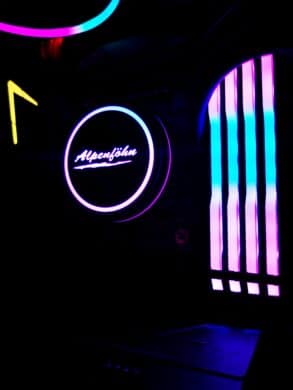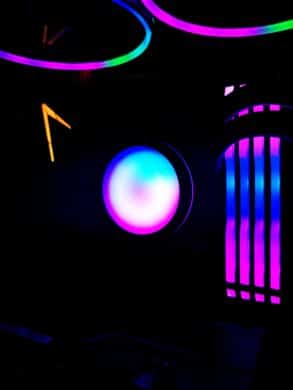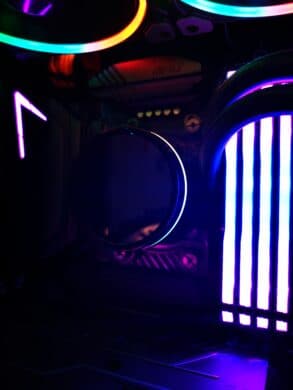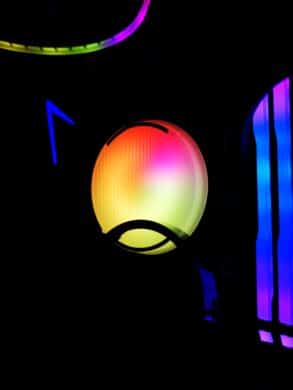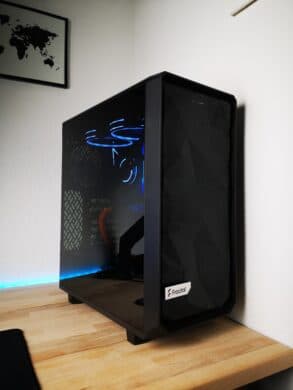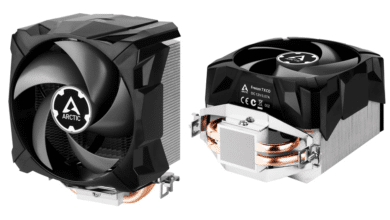
The Alpenföhn Gletscherwasser, designed in collaboration with the rock star of the overclocking scene Roman “der8auer” Hartung for top performance. This promises top performance and a very practical implementation. In the past, we were already allowed to test the 360-mm variant in detail. Which more than convinced us and has directly cleared a platinum award.
The product family “Gletscherwasser” now gets a new member, in addition to the variants with 240-mm and 360-mm radiator, Alpenföhn now also has a 280-mm version on offer. In our test, we compared the 240 mm High Speed and the 280 mm Gletscherwasser, not only visually, but also based on the cooling performance. Which differences were shown and how the two watercoolers perform, you can learn in our following test report.
Specifications
| Model | 240 mm – High Speed | 280 mm |
| Dimensions radiator incl. fan ( H x W x D /mm) | 52 x 282 x 120 | 52 x 322 x 138 |
| Socket compatibility | Intel LGA: 1200 / 1150 / 1151 / 1155 / 1156 / 1366 / 2066 / 2011-V3 / 2011 AMD: TR4 / sTRX4 / AM4 / AM3+ / AM3 / AM2+ / AM2 / FM1 |
Intel LGA: 1200 / 1150 / 1151 / 1155 / 1156 / 1366 / 2066 / 2011-V3 / 2011 AMD: TR4 / sTRX4 / AM4 / AM3+ / AM3 / AM2+ / AM2 / FM1 |
| Number, fan model, size | 2x Alpenföhn Wing Boost 3 ARGB 120mm | 2x Alpenföhn Wing Boost 3 ARGB 140mm |
| Fan speed (rpm) | 500 – 2200 | 500 – 2000 |
| Fan Volume (dB(A)) Pump / fan @ 100% power |
17.8 / 36.8 | 17.8 / 36.4 |
| Pump speed. (rpm) |
1200 – 2550 | 1200 – 2550 |
| Bottom plate pump | copper | copper |
| Connection of the pump | 3-pin | 3-pin |
| Tube length (in mm) | 380 | 410 |
| Refill port | present | present |
| Price | € 138.24 * | €184.90 |
Scope of delivery
The included accessories are identical in both cases and very extensive. Let’s start with the things that are the same. Included are various screws and mounting frames for the respective sockets of the compatible processors. Screws as well as mounting frames make a very high-quality impression.
In addition to the mounting accessories, Alpenföhn also provides the user with a Y-cable for connecting the fans to the motherboard. For the lighting, a splitter cable for the RGB lighting of the fans and the pump is included. For this, we have the option to connect the lighting directly to the mainboard and control it via any software. If there is no 3-pin RGB port on the motherboard, Alpenföhn offers the option to power the lighting via the included SATA cable and then control the lighting via the included remote.
A small highlight is the thermal paste, a premium product from Thermal Grizzly is included here. With accompanying instructions and a spatula, application becomes a breeze.
An assembly guide, on which the complete scope of delivery is printed once again, is also included in the box. Also included are a total of 5 logo plates, which we will discuss in more detail later in this review.
Let’s move on to the things that differentiate the two water cooling systems. These are pretty obvious. The two radiators differ in size and therefore radiator area. The 240mm version offers a total area of 338.4cm² and the 280mm version offers an area of 444.36cm². The fans also differ in size. The 240 mm version uses two 120 mm Alpenföhn Wingboost 3 ARGB fans in the high-speed version. The 280 mm variant, on the other hand, relies on two 140 mm Alpenföhn Wingboost 3 ARGB fans. The fans also differ in their maximum speed. The 120 mm fans reach 2200 rpm at full load, whereas the 140 mm fans “only” reach 2000 rpm.
Design and workmanship
The radiator is finished in sleek black. After unpacking, we could not see any damage or faulty construction on the fins. The tubing on both models is covered in a black braided sheath, and a difference can be seen here on the respective models. The hose on the 240mm model is 38cm long and on the 280mm water cooling model it is 41cm long. This difference can be explained due to the longer radiator, more distance has to be bridged from the connection of the hoses to the radiator to the mounted pump on the processor. The case of the pump is covered with a glossy black paint. This shines very nicely, but also quickly accumulates dust or you can see the dust very clearly.
Between the lid and the rest of the case there is a kind of white ring that glows when the power is on. A nice effect, in our opinion. The lid can be removed by simply turning it and it is thus offered the possibility to change the logo plate. We already know a similar approach from the Deepcool Castle EX, for example. Inside the lid as well as on the fans, a freely controllable RGB lighting can be found again, which can be configured via e.g. MSI Mystic Light. This also works very well in reality.
The overall workmanship is exceptional and no weaknesses can be seen. Even the logo plates are very thick and sturdy. The braiding on the hose also doesn’t show any flaws in the form of fraying or protruding parts. Real premium quality thus!
Fans
The fans were given an RGB ring, this can be seen in two ways. Once when you look directly at the fan blades on it and then also from the side. Here you can even see two lines. The lateral visibility of the lighting appealed to us and offers a unique look. The contact points of the fans are rubberized and thus reduce vibrations, which is good for the volume. In addition, the fans have two cables. One cable with a 4-pin PWM connector and one with a 3-pin ARGB connector.
Installation and practice
Installation into our existing system went very well with no further complications. We installed the 240mm version in the lid and the 280mm version in the front. Simply because the Meshify 2 Compact provides it that way. For the installation, Alpenföhn has deposited a small PDF with an orientation note on their website. We followed this of course and chose the installation method with the hoses downwards for the 280 mm variant. The graphic can be seen on the orientation note in the bottom left corner. For the 240-mm variant, we followed the upper left graphic. Sticking to the left column of the note benefits efficiency and volume.
There is also a little help for applying the thermal paste. Nothing other than a premium product is included here, namely a small syringe full of Thermal Grizzly Hydronaut. In addition, there is a spatula to apply the paste perfectly and without dirty fingers on the surface of the processor.
Logo plate and lighting
The solution with the plates has been very well received by us. They are easy to replace and the Alpenföhn, Thermal Grizzly and AMD logos that are already cut out can be seen. Also included are a black and a transparent plate. The black plate completely dims the lighting inside, so only the outer ring shines. The transparent plate, on the other hand, lets you look deep and exposes the entire lighting effect. You also have the option here to stick on a logo of your choice.
The lighting can be easily controlled via the software of your motherboard. Among them, the popular manufacturers, ASRock Polychrome, Asus Aura, MSI Mystic Light and RGB Fusion. Users without a 3-pin ARGB connector on the motherboard have also been considered. Because, if you connect all lighting components to the SATA port, the lighting can be conveniently controlled via the included remote control. Various effects and speeds are also available with the remote control.
Performance test
To stay as practical as possible, we didn’t test the water coolers on a benchtable, but instead installed them in Fractal Design’s new Meshify 2 Compact case. The Gletscherwasser served as cooling for a Ryzen 5 3600 in our performance test. To get the 3600 Ryzen up to temperature properly, we put it through a 20 minute Prime95 stress test.
Test system:
- AMD Ryzen 5 3600*
- MSI MPG B550 Gaming Carbon Wi-Fi*
- Corsair Vengeance RGB Pro 3200 MHz*
- Gigabyte 1660 Super OC
- Seasonic GC 500W*
- LINKUP – PSU cable extension sleeved*
- Fractal Design Meshify 2 Compact*
In order to get a comparable value, we didn’t test the two water cooling systems at a certain speed, but at 50% and 100% fan power respectively. It should be noted that the 240 mm variant is the one equipped with the high-speed fans. The 280 mm version offers a larger radiator and fan area. In addition, the 140 mm fans (2000 rpm) have just 200 rpm less power than the 120 mm high-speed variant (2200 rpm). The air throughput is drastically higher with the 140 mm fans (120 mm – 132.4 m³/h; 140 mm – 175.6 m³/h). Of course, the air throughput also results from the fan speed. You can see the results in the table below.
| Product | Temperature at 50% PWM | Temperature at 100% PWM |
| 240 mm high speed | 62.7 °C | 59.6 °C |
| 280 mm | 61.6 °C | 54.1 °C |
As a comparison, we have once added the values of the be quiet! Pure Loop 360 water cooling tested in the past, under the same conditions.
| Product | Temperature at 50% PWM | Temperature at 100% PWM |
| bequiet!Pure Loop 360 | 62.2 °C | 58.6 °C |
As you can see, the cooling concept of the Gletscherwasser All-in-Ones works pretty well. The temperatures turn out almost the same or even better in some cases than with a larger 360 mm water cooling system with a powerful pump. At 100% fan power, the Glacier Water 280 leaves all others far behind. The reason for this can also be the mounting in the front, because the fresh air is directly sucked in here and used for cooling without detours. Nevertheless, a great performance. The 140 mm fans are clearly audible even at a performance of 50%. From a speed of around 800 rpm, the soundscape becomes pleasant and the fans are as good as silent. All of the listed water cooling systems were tested with Thermal Grizzly’s thermal paste, so there are no drawbacks here either.
Conclusion
The Gletscherwasser 240 High Speed as well as the new 280 mm variant have convinced us. In addition, the cooling values, from our performance test, virtually blew our minds. With 54.1 °C, it even beats 360 mm AiO water cooling systems by far. All in all, the workmanship is very solid, as is the choice of materials. The RGB lighting is very easy to control and even users without a 3-pin ARGB connector on the motherboard have been considered. For them, a remote control is included, which can be used to control the lighting. You don’t have to do without any effect and can be gently sprinkled with RGB. The included logo plates also make a lasting impression – positively, of course. There is also the option of sticking on a self-printed logo. However, a plotter or another suitable cutting tool is recommended for this.
The 3-phase motor is quiet and offers decent power. During our tests and also when listening more closely, we could only hear a very slight whirring, which was not annoying at all. The included fans of both models also make a very solid impression. The choice of materials and the general workmanship convinced us. At full speed, both 120 mm and 140 mm fans seemed very loud. Compared to models from other manufacturers, even louder. On the positive side, however, they probably never run at 100% power as a rule or in daily use and probably never have to in view of the tested temperatures. You get a lot for a price of around €190, so we consider the price high but reasonable due to the workmanship and cooling performance. Therefore, we once again give a Platinum Award for both models.

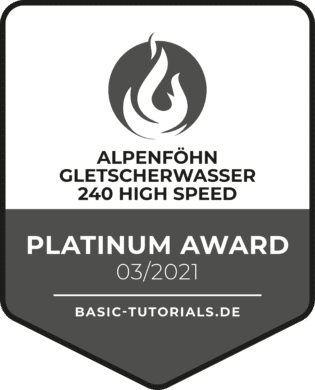
Alpenföhn Gletscherwasser 240 High Speed & Gletscherwasser 280
Design
Workmanship
Mounting
Cooling
Volume
Value for money
97/100
Extraordinarily good cooling performance coupled with first-class build quality is offered to the user in the 240mm High Speed and 280mm models.




